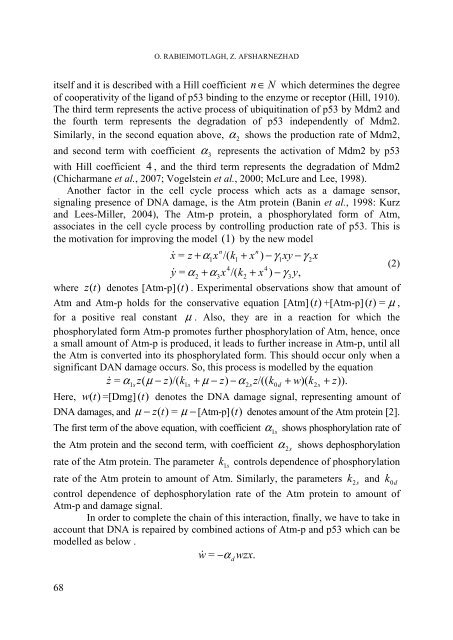biologia - Studia
biologia - Studia
biologia - Studia
You also want an ePaper? Increase the reach of your titles
YUMPU automatically turns print PDFs into web optimized ePapers that Google loves.
O. RABIEIMOTLAGH, Z. AFSHARNEZHAD<br />
itself and it is described with a Hill coefficient n ∈ N which determines the degree<br />
of cooperativity of the ligand of p53 binding to the enzyme or receptor (Hill, 1910).<br />
The third term represents the active process of ubiquitination of p53 by Mdm2 and<br />
the fourth term represents the degradation of p53 independently of Mdm2.<br />
Similarly, in the second equation above, α<br />
2<br />
shows the production rate of Mdm2,<br />
and second term with coefficient α<br />
3<br />
represents the activation of Mdm2 by p53<br />
with Hill coefficient 4 , and the third term represents the degradation of Mdm2<br />
(Chicharmane et al., 2007; Vogelstein et al., 2000; McLure and Lee, 1998).<br />
Another factor in the cell cycle process which acts as a damage sensor,<br />
signaling presence of DNA damage, is the Atm protein (Banin et al., 1998: Kurz<br />
and Lees-Miller, 2004), The Atm-p protein, a phosphorylated form of Atm,<br />
associates in the cell cycle process by controlling production rate of p53. This is<br />
the motivation for improving the model (1) by the new model<br />
n<br />
n<br />
x&<br />
= z + α1x<br />
/( k1<br />
+ x ) −γ<br />
1xy<br />
−γ<br />
2x<br />
(2)<br />
4<br />
4<br />
y&<br />
= α<br />
2<br />
+ α3x<br />
/( k2<br />
+ x ) − γ<br />
3y,<br />
where z (t)<br />
denotes [Atm-p] (t)<br />
. Experimental observations show that amount of<br />
Atm and Atm-p holds for the conservative equation [Atm] (t)<br />
+[Atm-p] (t)<br />
= µ ,<br />
for a positive real constant µ . Also, they are in a reaction for which the<br />
phosphorylated form Atm-p promotes further phosphorylation of Atm, hence, once<br />
a small amount of Atm-p is produced, it leads to further increase in Atm-p, until all<br />
the Atm is converted into its phosphorylated form. This should occur only when a<br />
significant DAN damage occurs. So, this process is modelled by the equation<br />
z&<br />
= α1s z(<br />
µ − z)/(<br />
k1s<br />
+ µ − z)<br />
−α<br />
2sz/((<br />
k0d<br />
+ w)(<br />
k2s<br />
+ z)).<br />
Here, w (t)<br />
=[Dmg] (t)<br />
denotes the DNA damage signal, representing amount of<br />
DNA damages, and µ − z (t) = µ − [Atm-p] (t)<br />
denotes amount of the Atm protein [2].<br />
The first term of the above equation, with coefficient α<br />
1s<br />
shows phosphorylation rate of<br />
the Atm protein and the second term, with coefficient α<br />
2s<br />
shows dephosphorylation<br />
rate of the Atm protein. The parameter k 1<br />
controls dependence of phosphorylation<br />
rate of the Atm protein to amount of Atm. Similarly, the parameters<br />
s<br />
k 2 s<br />
and k 0 d<br />
control dependence of dephosphorylation rate of the Atm protein to amount of<br />
Atm-p and damage signal.<br />
In order to complete the chain of this interaction, finally, we have to take in<br />
account that DNA is repaired by combined actions of Atm-p and p53 which can be<br />
modelled as below .<br />
w&<br />
= −α wzx.<br />
d<br />
68
















